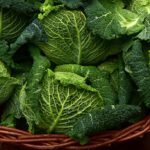Do you want to increase your energy levels and improve your immune system through dietary alterations? Although magnesium is deemed a minor nutrient, it is crucial to all bodily functions and tissues, and plays a vital role in maintaining overall health.
According to a study published in Cell in January 2022, magnesium may contribute to fighting specific cancers, in addition to promoting a strong immune system and enhancing bone health.
Research has shown that foods containing magnesium can enhance heart health, prevent stroke, and may also lower the likelihood of dying from a heart attack. The NIH also states that these foods assist in maintaining regular nerve and muscle function and keeping a steady heartbeat.
According to a systematic review and meta-analysis, consuming a large amount of magnesium on a daily basis may lower the chances of developing type 2 diabetes by 22 percent and experiencing stroke by 11 percent.
Raising Magnesium Quickly Through Diet
The American adults are advised by the U.S. Department of Health and Human Services to consume magnesium within the range of 310 to 420 milligrams (mg) on a daily basis.
According to NIH, even though 30 to 40 percent of the magnesium intake is absorbed by the body, there is still a possibility of magnesium deficiency due to underlying health conditions, alcoholism, or specific medication. As per a review, almost two-thirds of the Western World are not able to meet the recommended daily intake of magnesium.
Although magnesium supplements can be purchased without a prescription at supermarkets and pharmacies, it is advised by dietitians to consume whole foods that are naturally high in magnesium in order to prevent a magnesium deficiency. To satisfy your magnesium intake, foods rich in dietary fiber such as nuts, whole grains, and whole or dried fruits and vegetables are recommended by the National Institutes of Health (NIH).
1. Dark Leafy Greens
Opt for either raw or cooked dark leafy greens that are rich in magnesium, like baby spinach, collard greens, kale, or Swiss chard. These greens are considered the ultimate superfood due to their provision of crucial vitamins and minerals, in addition to various potential health advantages.
If you consume dark leafy greens, you can prevent magnesium deficiency without consuming too many calories. The USDA estimates that one cup of raw kale contains almost 7 mg of magnesium, which helps you get closer to your daily magnesium requirements.
To provide an example, cooked spinach, amounting to 1 cup or 180 grams, contains 158 mg of magnesium, which equals to 37% of the recommended daily value. Moreover, leafy greens such as spinach are rich in nutrients such as iron, manganese, and vitamins A, C, and K.
Leafy greens also contain many beneficial plant compounds, which help protect your cells from damage and may reduce cancer risk. Leafy greens are a very good source of many nutrients, including magnesium. A 1-cup (180-g) serving of cooked spinach provides an impressive 37% of the DV.
2. Nuts and Seeds
Dry roasted almonds are considered a good source of magnesium, with only 1 ounce (oz) containing 79mg of the mineral according to the USDA. The Cleveland Clinic adds that other magnesium-rich foods include cashews, peanuts, and pumpkin seeds.
Make a nutritious trail mix by mixing your preferred nuts and seeds that are high in magnesium. This is ideal for a satisfying afternoon snack that will keep you energized and feeling full. It’s crucial to note, however, that nuts have a high calorie count, as indicated by the Academy of Nutrition and Dietetics, so moderation is key, especially if you’re trying to lose weight.
Almonds, cashews, and Brazil nuts are among the types of nuts with a high magnesium content. For example, a single serving of cashews weighing 1 oz. (28 g) contains 83 mg of magnesium, which accounts for 20% of the recommended daily value.
Additionally, nuts are a great source of monounsaturated fat and fiber that have been proven to enhance blood sugar and cholesterol levels of individuals with diabetes. Furthermore, Brazil nuts have an exceptionally high amount of selenium, with a single nut fulfilling almost 175% of the daily value for this mineral.
Furthermore, nuts exhibit anti-inflammatory properties, promote heart health, and can suppress hunger when consumed as snacks. Magnesium, along with numerous other vital nutrients, is abundant in cashews, almonds, and Brazil nuts. Consuming a serving of cashews alone can fulfill 20% of the daily value.
3. Fatty Fish Such As Salmon and Tuna
Incorporate fish varieties such as mackerel, salmon, halibut, and tuna into your dietary plan in order to increase your magnesium levels, as well as obtain vitamin D and omega-3 fatty acids.
To meet your daily magnesium requirement, the USDA suggests consuming at least two servings of fish per week, preferably fatty varieties such as salmon and albacore tuna. A single 3-ounce cooked farmed Atlantic salmon fillet can supply 25.5 mg of magnesium, according to the AHA.
Cooked salmon weighing 3.5 ounces (100 grams) contains 30 mg of magnesium, which is 7% of the recommended daily value. Furthermore, it boasts 22 g of top-notch protein. Fish is also an abundant source of potassium, selenium, B vitamins, and other essential nutrients.
Furthermore, the consumption of fatty fish in large quantities is associated with a lower chance of developing various long-term illnesses like heart disease. The presence of abundant omega-3 fatty acids in these fish is the reason behind the observed advantages.
An excellent source of magnesium and various other nutrients, fatty fish is highly nutritious. Cooked salmon in a 3.5-oz. (100-g) serving provides 7% of the DV for magnesium. Not only that, consuming fish may also provide a mental health boost – according to a previous review, there could be a correlation between fish consumption and a reduced occurrence of mental health disorders like depression.
4. Soybeans
A source of magnesium, fiber, vitamins, minerals, and amino acids, the soybean is high in protein’s building blocks.
Consider snacking on a ½ cup portion of dry roasted soybeans. The USDA estimates that this would provide you with significant amounts of energy (209 calories), protein (20.2 g), and magnesium (106 mg). Alternatively, you can add fresh soybeans, also known as edamame, to your grocery list. Legumes such as black beans and kidney beans are also rich in magnesium, according to the NIH.
5. Avocado
Rich in vitamins, heart-friendly nutrients, and compounds that prevent diseases, avocados are also a reliable source of magnesium. By incorporating half an avocado into your salad or whole-grain toast, you can consume 19.7 mg of magnesium, as per USDA standards, which contributes significantly towards fulfilling your daily requirement.
Avocados, like nuts, contain substantial amounts of healthy fats, as stated by the Academy of Nutrition and Dietetics, resulting in a high calorie content. Therefore, if weight management or reduction is a personal objective, it is crucial to be mindful of serving size when consuming this nutritious treat.
Additionally, avocados have significant amounts of potassium, B vitamins, and vitamin K. Moreover, unlike the majority of fruits, they contain copious amounts of fat, particularly monounsaturated fat, which is beneficial for the heart. Additionally, avocados are a remarkable source of fiber. As a matter of fact, a large portion of the carbohydrates in an avocado is fiber, resulting in its low digestible carbohydrate content.
Numerous researches have indicated that avocados can decrease inflammation, enhance cholesterol levels, and promote satiety following meals. Magnesium, which constitutes 14% of the recommended daily value, is present in a medium-sized avocado. Avocados contain a wealth of other nutrients and have the potential to lessen inflammation, enhance cholesterol levels, and promote satiety.
6. Banana
Bananas may be best known for being rich in heart-healthy and bone-strengthening potassium, but a medium-size banana also provides 32 mg of magnesium, in addition to 10.3 mg of vitamin C (a good source) and 3 g (a good source) of fiber, according to the USDA.
In addition to the avocado already mentioned, it is worth considering apples as another fruit that contains magnesium. As per the USDA, a medium-sized gala apple with its skin on provides not only magnesium (8.6 mg) but also a wealth of other essential nutrients such as 4 g of fiber and 1.7 mcg of vitamin A.
Furthermore, bananas contain a considerable amount of magnesium, with a single large banana providing 37 mg of magnesium, equating to 9% of the recommended daily value. Additionally, bananas offer a source of vitamin C, vitamin B6, manganese, and fiber. Individuals adhering to a low-carbohydrate diet may find ripe bananas unsuitable, as they possess higher levels of sugar and carbohydrates in comparison to other fruits.
Nonetheless, a significant amount of the carbohydrates found in unripe bananas consists of resistant starch, which is indigestible and not absorbed by the body.
Lowering blood sugar levels, reducing inflammation, and enhancing gut health are additional benefits that resistant starch may provide. A variety of important nutrients can be obtained from bananas. A single large banana can supply 9% of the daily value for magnesium.
7. Dark Chocolate
Getting your magnesium intake through dark chocolate is a delicious option. According to the USDA, consuming one oz or one square of dark chocolate that contains 70-85 percent cacao can provide 64.6 mg of magnesium, which is considered a good source. Additionally, research suggests that dark chocolate has flavanols that function as antioxidants and may promote lower blood pressure, improved blood circulation, and reduced inflammation.
8. Nonfat or Lowfat Greek Yogurt
According to the USDA, one 6-oz container of nonfat or low-fat Greek yogurt contains about 18.7 mg of magnesium and 17.5 g of protein. Prior studies indicate that consuming high-protein meals can prolong the feeling of fullness, resulting in reduced overall calorie intake, leading to weight loss. For a nutritious and effortless breakfast, team up yogurt with a fruit that is rich in fiber.
Legumes, which consist of lentils, beans, chickpeas, peas, and soybeans, are a group of plants that are high in nutrients. They are particularly abundant in a wide variety of nutrients, including magnesium. For example, if you consume a 1-cup (172-g) portion of cooked black beans, you will receive a remarkable 120 mg of magnesium, which equates to 29% of the DV.
Legumes, being a major source of nutrients, are also abundant in potassium and iron. With a low glycemic index and high fiber content, they present an opportunity for lowering cholesterol, managing blood sugar, and mitigating the risk of heart disease.
Natto, a soybean product that has undergone fermentation, is recognized as a superb supplier of vitamin K2, an essential nutrient for maintaining strong bones. Legumes are high in magnesium, with black beans providing 29% of the daily value per 1-cup (172-g) serving.
Its high protein content makes tofu a staple in vegetarian diets. This food, also called bean curd, is made by pressing soybean milk into soft white curds. A serving of 3.5 oz (100g) contains 35 mg of magnesium, which is equivalent to 8% of the daily value (DV).
In addition, a single portion delivers 10 g of protein and significant levels of calcium, iron, manganese, and selenium.
Moreover, there are indications from certain studies that consuming soy products such as tofu can safeguard the endothelial cells of your arteries and may potentially lower the likelihood of developing stomach cancer. A single portion of tofu fulfills 8% of the recommended daily value for magnesium and also contains high-quality protein and multiple beneficial nutrients.
Seeds are highly beneficial to health, especially those like flax, pumpkin, and chia seeds which are rich in magnesium. Among these options, pumpkin seeds stand out as they offer a considerable amount of 168 mg per 1-oz. (28-g) serving – equivalent to an impressive 40% of the recommended daily value for magnesium.
Furthermore, seeds boast a wealth of iron, monounsaturated fat, and omega-3 fatty acids while also being remarkably abundant in fiber. To illustrate, fiber accounts for almost half of the carbohydrates present in most seeds.
In addition, flaxseeds have antioxidants that shield your cells from detrimental free radicals that arise during metabolic processes. Moreover, studies have demonstrated the potential of flaxseeds to lower cholesterol and provide advantages in the fight against breast cancer.
Most seeds are rich in magnesium. In fact, a 1-oz. (28-g) serving of pumpkin seeds contains around 40% of the DV.
The category of grains comprises of wheat, oats, and barley, as well as pseudocereals like buckwheat and quinoa. Whole grains are rich in various nutrients such as magnesium. When a person consumes a 1-cup (168-g) serving of cooked buckwheat, they obtain 86 mg of magnesium, which accounts for 20% of the Daily Value (DV).
Whole grains typically contain significant amounts of B vitamins, selenium, manganese, as well as fiber.
Research has revealed that whole grains can reduce inflammation as well as decrease various risk factors linked to heart disease. Additionally, whole grains boast of high nutrient content, with magnesium being one of them. A cooked buckwheat serving of 1 cup (168-g) contains 20% of the recommended daily intake for magnesium.
Your daily diet may not contain sufficient amounts of the essential mineral, magnesium. Luckily, there are numerous healthy foods that can assist in meeting your requirements. It is essential to have a well-rounded diet that encompasses some of the mentioned foods to enhance magnesium and other vital nutrients intake.



